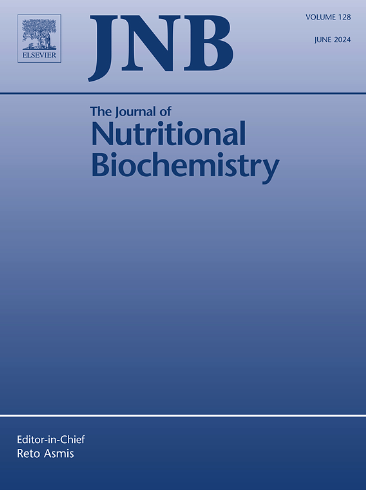中链甘油三酯通过上调 AMPK 信号通路激活棕色脂肪组织,从而减轻肥胖。
IF 4.8
2区 医学
Q1 BIOCHEMISTRY & MOLECULAR BIOLOGY
引用次数: 0
摘要
中链三酰甘油(MCT)是一种主要由中链脂肪酸(MCFA)组成的健康脂质,已被证实具有改善代谢紊乱、降低血液胆固醇和控制体重的生理活性。棕色脂肪组织(BAT)具有生热和耗能功能,因此被认为是一种潜在的抗肥胖器官。以前的报告发现,富含 MCT 的饮食有助于激活棕色脂肪组织。然而,MCT 与 BAT 之间的潜在机制仍然未知。本研究将 MCFA 应用于 C3H/10T1/2 细胞分化的棕色脂肪细胞,并将 MCT 应用于高脂饮食(HFD)诱导的肥胖小鼠。结果表明,MCFA 和 MCT 能诱导脂肪细胞棕色化和活化 BAT,显著增加线粒体的富集,并显著降低细胞内脂质积累和体内外体重。从机理上讲,MCT 能明显提高 UCP1、AMPK 及下游信号因子 Pgc1α 和 Ulk1 的水平,进一步明显提高棕色分化因子 Pparγ。此外,AMPK抑制剂多索吗啡(dorsomorphin)部分削弱了MCT的有益作用。总之,本研究证明了AMPK是MCT诱导BAT活化的潜在靶点,为MCT在未来的应用提供了理论依据。本文章由计算机程序翻译,如有差异,请以英文原文为准。

Medium-chain triglyceride attenuates obesity by activating brown adipose tissue via upregulating the AMPK signaling pathway
Medium-chain triacylglycerol (MCT) is a healthy lipid mainly composed of medium-chain fatty acids (MCFA), which has been proven to have physiological activities in improving metabolic disorders, reducing blood cholesterol, and controlling weight. Brown adipose tissue (BAT) has been regarded as a potential organ to fight obesity due to the function of thermogenesis and energy dissipation. Previous reports found that a diet rich in MCT contributed to the activation of BAT. However, the potential mechanism between MCT and BAT remains unknown. In the current study, MCFA was applied on C3H/10T1/2 cells differentiated brown adipocytes, and MCT was applied on high-fat diet (HFD) induced obese mice. The results showed that MCFA and MCT induced browning of adipocytes and activation of BAT, significantly increased the enrichment of mitochondria, and significantly reduced intracellular lipid accumulation and body weights in vivo and in vitro. Mechanically, MCT significantly increased the level of UCP1, AMPK, and the downstream signaling factors of Pgc1α and Ulk1, further significantly elevated the brown differentiation factor of Pparγ. Moreover, The AMPK inhibitor dorsomorphin partially impaired the beneficial effects caused by MCT. In conclusion, this study proved that AMPK is the potential target of MCT to induce BAT activation and provided theoretical evidence for the application of MCT in the future.
求助全文
通过发布文献求助,成功后即可免费获取论文全文。
去求助
来源期刊

Journal of Nutritional Biochemistry
医学-生化与分子生物学
CiteScore
9.50
自引率
3.60%
发文量
237
审稿时长
68 days
期刊介绍:
Devoted to advancements in nutritional sciences, The Journal of Nutritional Biochemistry presents experimental nutrition research as it relates to: biochemistry, molecular biology, toxicology, or physiology.
Rigorous reviews by an international editorial board of distinguished scientists ensure publication of the most current and key research being conducted in nutrition at the cellular, animal and human level. In addition to its monthly features of critical reviews and research articles, The Journal of Nutritional Biochemistry also periodically publishes emerging issues, experimental methods, and other types of articles.
 求助内容:
求助内容: 应助结果提醒方式:
应助结果提醒方式:


